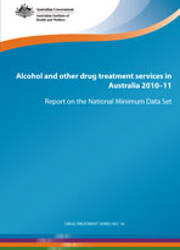Summary
The use of alcohol and other drugs is among the leading causes of illness and disability in Australia. In 2003, drug and alcohol use accounted for 12% of the total burden of disease. In 2010, 15% of Australians aged 14 or more had recently used illicit drugs, 15% were daily smokers and 80% used alcohol.
This report presents data about alcohol and other drug treatment agencies, their clients, drugs of concern and the type of treatment received.
The total number of treatment episodes provided to clients has increased
In 2010-11, around 150,500 closed treatment episodes were recorded, of which 144,000 (96%) were for clients seeking treatment for their own substance use. This is an increase from approximately 145,600 treatment episodes in 2009-10. Clients seeking treatment for their own drug use tended to be younger (median age of 33) than those seeking assistance for someone else's drug use (median age of 41). Two in 3 episodes where clients were seeking treatment for their own drug use involved males (97,800 episodes, 68%).
Around 1 in 8 (19,600 episodes, 13%) of the total closed treatment episodes involved clients who identified as being of Aboriginal or Torres Strait Islander origin, while they represent approximately 2.2% of the Australian population aged 10 and over. Most episodes involved clients who were born in Australia (130,300 episodes, 87%).
Alcohol continues to be the most common principal drug of concern
Alcohol continued to be identified as clients' principal drug of concern most commonly, representing almost half of the total closed treatment episodes (68,200 episodes, 47%) in all jurisdictions, except Tasmania, where cannabis was equally common. Cannabis (31,800 episodes, 22%), heroin (13,400 episodes, 9%) and amphetamines (12,600 episodes, 9%) were the next most common principal drugs of concern reported consistently across the years. There was a steady decline in treatment episodes with heroin identified as the principal drug of concern, from a peak of 2 in 10 (23,300 episodes, 18%) in 2003-04 to 1 in 10 (13,400 episodes, 9%) in 2010-11. Just under half of treatment episodes (70,900 episodes, 49%) involved multiple drugs of concern.
Counselling continues to be the most common treatment type
Counselling was the most common main treatment type (61,900 episodes, 41%) followed by withdrawal management (23,800 episodes, 16%) and assessment only (20,500 episodes, 14%). Counselling was nearly twice as common for those seeking treatment for someone else's drug use (75%) than for those seeking treatment for their own drug use (40%). Counselling treatment episodes had the longest median duration (57 days). Seven in 10 (102,300 episodes, 68%) episodes were closed due to an 'expected/compliant completion'.
The number of treatment agencies has remained relatively stable
In 2010-11, 666 alcohol and other drug treatment agencies provided data for the AODTS- NMDS. This is the second highest number of reporting treatment agencies since reporting began in 2001-02. The proportion of government and non-government sector agencies remained relatively stable between 2009-10 and 2010-11 (54% non-government sector and 46% government sector). Half of the treatment agencies (344 agencies, 52%) were located in major cities and almost 3 in 10 (182 agencies, 27%) were in inner regional areas.



